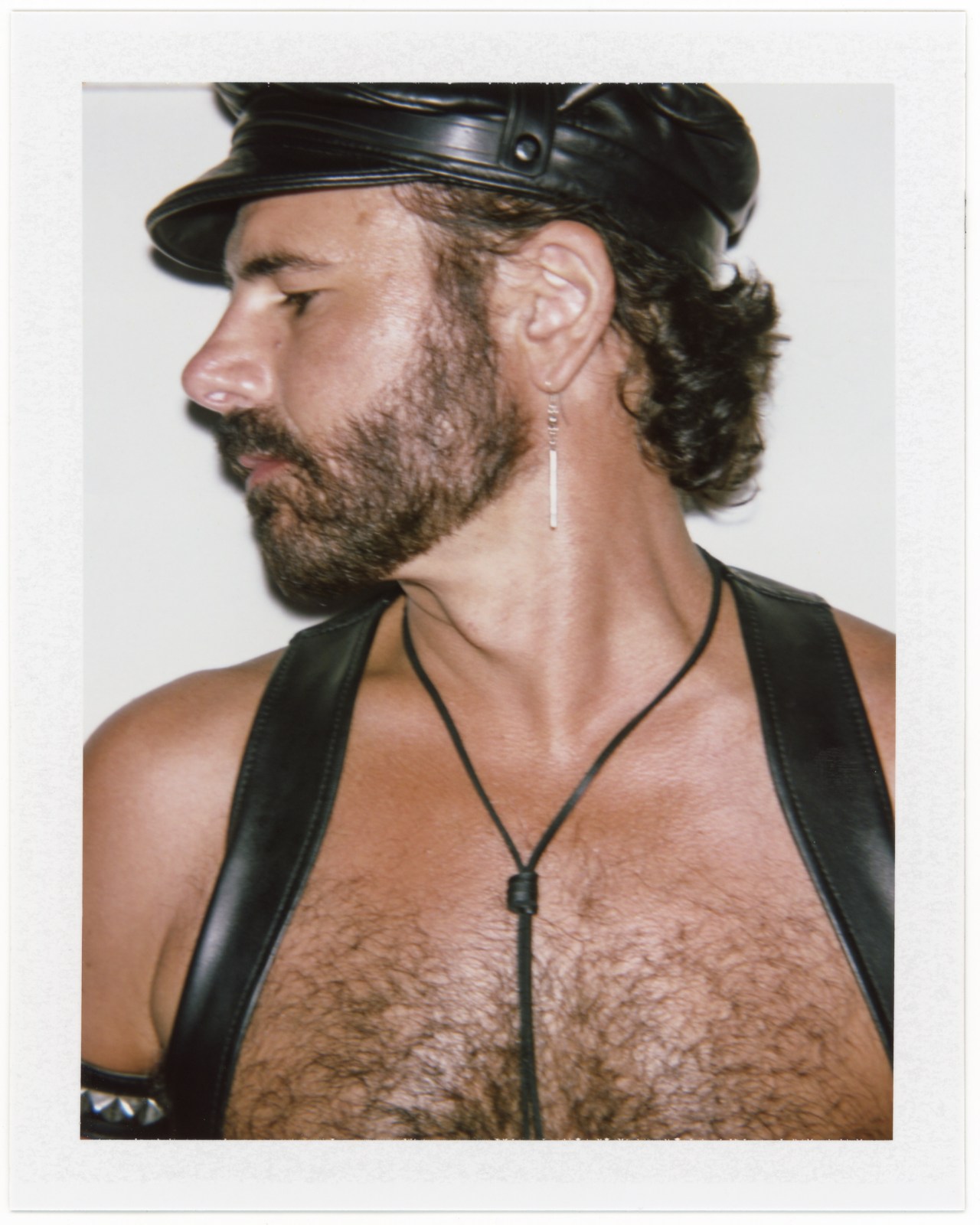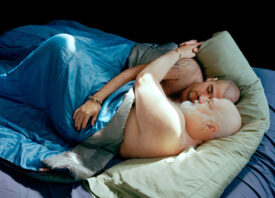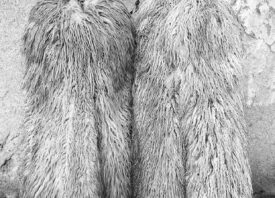Search this site
Polaroid Portraits Celebrate Provincetown’s Queer Community

Provincetown, MA
Years ago, Michael Joseph spent a week renting a house with friends in Provincetown, a seaside town at the tip of Cape Cod. The early mornings were cool and foggy; in the evenings, the light of the setting sun turned the street gold. He spent nights dancing until the clubs closed and making his way through the crowd at Spiritus Pizza, a local haunt dating back to the 1970s.
“It was a bonding time and a time that contributed to forming identity,” the artist says, looking back on those days and nights. He remembers the sunlight, the salty air, and perhaps, most of all, he remembers the people. In the summers that have followed, he’s returned to Provincetown, a place where more than a century of LBGTQ+ history continues to inspire new generations.
Walking down the iconic Commercial Street, he photographs people—travelers, artists, business owners, drag performers, couples, and youngsters among them—using a vintage Polaroid Big Shot camera. (Coincidentally, the camera was released the same year Spiritus Pizza opened for business, in 1971.) Those Polaroid portraits are part of the ongoing project Wild West of the East (@wildwestoftheeast on Instagram).
“Provincetown is a small town with a large history,” Joseph tells me. “It’s as far of a drive as one can make to the end of the Cape. It often feels like the end of the earth, surrounded by water on three sides with light coming in every direction.”
In the 1980s, it was in Provincetown that Tim O’Connor and John Michael Gray, also known as the Hat Sisters, won fans over with their whimsical designs, activism, and fundraising efforts. In 2004, when Massachusetts became the first state to legally recognize same-sex marriage, people traveled there for their weddings. Now, events like Carnival, Bear Week, and Family Week continue to welcome LGBTQ+ people and allies of all ages.
We asked Joseph to tell us about this seaside town and the people he’s met along the way.

What are some of your earliest memories of the Queer community in Ptown?
“I learned about queer culture from those I met and from what I took in by my surroundings. Most don’t realize that when one ‘comes out’ there is another whole period of figuring out one’s place in the queer community. The queer community is extremely diverse unto itself. Every human being seeks out their place within society, but then members of the LGBTQ+ community undergo another search, within this smaller, diverse segment of society.
“My time spent there is always special. Time there feels like the world slows down and one can easily ‘be present.’ For those who ever feel ‘other’ because of heteronormality or feel fully introverted, Provincetown offers a place of inclusion, freedom, and little judgment.
“I’ve seen people travel from all over the country and the world to feel this freedom and be able to walk down the street, holding hands with their significant other and not think, for a minute, if anyone is watching or caring. I’ve seen nervous, shy visitors step off the ferry at the beginning of the week and do a complete 180 by the end of the week.
“Friends often joked that returning on the ferry or driving back home was like ‘re-entry.’ It was ‘re-entry’ into the world as it is rather than the way it could or should be. It was time to remember, that not everywhere or everyone is fully accepting and non-judgmental and self-regulation, whether realized or not, comes back into play.”

Provincetown, MA 2018

What is the atmosphere like on Commercial Street?
“Commercial Street is a very lively place, especially in the afternoons, and it’s my favorite place to shoot. Drag queens are barking to come see their shows, party-goers are en route to their next stop dressed in something unusual, boys whiz by on bikes ringing their bells, and people are walking back to the beach sun-kissed and tired.
“Well-known artists, actors, and writers, such as John Waters and John Cameron Mitchell, can be seen walking by or working on something new. During high season, the streets can be packed. Certain theme weeks bring different visitors.
“Each year, a Carnival celebration has a different theme, and those who partake go all out in special, hand-made costumes. It’s a day to celebrate life, freedom, and love. Mates Leather Weekend brings Leathermen to the streets, often bringing drawings of Tom of Finland to life with their full gear and outfits. Night brings out the well-dressed, headed to dinner or a show, and the barely dressed, headed to a club or party.”

Provincetown, MA 2018
Do you photograph many of the same people year after year, or is everyone new?
“For this project, I generally will not shoot the same person twice unless I see the opportunity to improve upon a previous portrait. I am not looking to document a subject’s evolution. I have limited film to work with, and I want to capture as many aspects of the town as possible. One quickly learns, by being in Provincetown, that the queer community has so many facets. There are quite a lot of subcultures within the culture. “

Provincetown, MA 2020
Can you walk us through your process of approaching someone for a Polaroid portrait?
“There are very specific times to capture people in their element as they walk up and down Commercial Street. During 4th of July Parades, Carnival, or a walk to ‘Tea Dance,’ a famous happy hour on a boat slip, people are dressed however they choose to freely represent themselves. I’ll pull store attendants out during breaks and sometimes approach people and set up a time to meet and shoot if they are busy.
“During the Pandemic, I had to set up sittings, which I am not used to. I’d meet my subject on the street and shoot outside, if possible, in a pre-planned way, just for safety. In general, I will walk up to a stranger, shake their hand, and introduce myself. I show them my funky camera and explain what I am working on. I always have a portfolio of images ready on my phone to flip through to show examples of the work. “

Provincetown, MA 2022
What draws you to people? What is it that makes you say, ‘I want to photograph that person’?
“I am drawn to people based on their look and confidence. I hope to capture people who are in the moment of being uniquely themselves. Provincetown gives people the license to fully express inner identity in a very outward way. I hope to capture this sense of authenticity.
“Last season, I captured a child who was being face-painted on the street. I noticed that he wanted to be painted as Wonder Woman. His parents didn’t say no, and they let him be painted as he wished. They put lipstick on him, and he was happy.
“These unedited moments of ‘play’ as children are almost the same as what adults seek and find in Provincetown. There are no societal rules saying what you can and can’t express. I’m sure the parents felt very safe allowing their child to be face-painted as whomever he wanted to be and walk around in public freely as such.”

Provincetown, MA 2022
Have there been many moments, interactions, or conversations you’ll never forget?
“Yes, absolutely. Seeing the child face-painted as Wonder Woman was one of them. On that same note, sometimes people call Provincetown ‘neverland,’ and I often can see grown adults behaving in child-like dress-up and ‘play’… something that we, as adults, put by the wayside or feel shameful about, but is such an important part of humanity that is missing and something we, perhaps, should return to.
“I also stopped a young man, Drew, who was dressed in his Carnival look. He comes to Provincetown to feel more like himself and experience the freedoms it has to offer. I later learned that he was making his Broadway debut in The Music Man.
“I stopped an older woman because she had a great face. She worked in Spiritus Pizza, and I caught her on break, with just enough time to make a few Polaroids. I later learned that her name was Sharon, the girlfriend of the famed Cookie Mueller, who was very much a part of the bohemian, queer past of Provincetown. Sharon and Cookie were friends with and featured in much of photographer Nan Goldin’s work.”

What made the Polaroid Big Shot your choice for this particular project? Why Polaroid portraits?
“I had been working in digital so long that I became used to the ability to make many, many portraits at once. I found that editing on the computer often left me choosing between multiple frames as ‘the one,’ and I wanted to make a major shift. I wanted to shoot in color, instantly, and have no ability to make any major changes to the work. I wanted the excitement of working with something tangible, precious, and serendipitous that produced an object.
“I often work up close, making intimate portraiture on the street. The Big Shot has a fixed focal length and is a big, weird-looking plastic camera. What better place to be walking around with an attention-getting camera than the streets of Provincetown?
“This camera’s product almost looks like an image you would use for an ID card, and even some pack film produced for it is meant for IDs. I wanted to play with that. How does one make an ID picture into a beautiful portrait? I spent a summer working with all types of Polaroid cameras such as the SX-70 or the older accordion style 250 models but fell in love with the Big Shot.
“Andy Warhol famously used the Big Shot both for photographic portraiture but also as the basis for his silkscreen paintings and prints. The Big Shot produces a specific look with hard flash that is perfect for shooting drag queens and club-kid type characters. One of my favorite times in art history is the East Village in the 1980s when Warhol was using this camera to capture portraits of celebrities.
“My project is named after Norman Mailer’s name for Provincetown, the ‘Wild West of the East’ and his thoughts on what the town represented. Norman Mailer traveled between NYC and Provincetown, as many did, and served as a connection of culture between the two. I wanted to keep that connection between the eras of the 1980s East Village and Provincetown.”

Provincetown, MA 2021
Do you see connections between your Ptown portraits and your other ongoing project, Lost and Found? If so, what are they?
My work is centered around intimate portraiture, highlighting subculture and identity. While this project might look different from “Lost and Found” on face value, it’s very much similar. Themes such as formation of identity, freedom outside of the confines of society, and found family permeate through both projects.”

Provincetown, MA 2020

Provincetown, MA 2021
Have you returned to Provincetown this year? For how long do you see yourself continuing to make these Polaroid portraits?
“I have already returned to Provincetown this May and started shooting. I’ll shoot up until the weather remains warm enough for the chemicals to develop correctly, which is about until early October. Currently, I am in year six of this project and will keep working until I run out of expired film.”


Provincetown, MA 2021
All images © Michael Joseph



